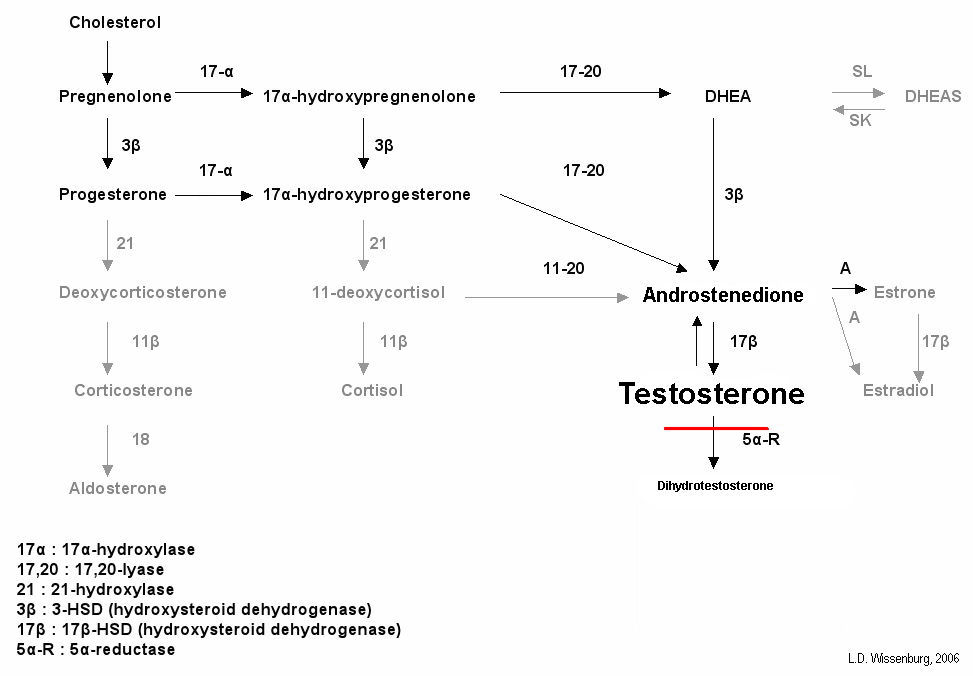5-alpha-reductase deficiency: Difference between revisions
m (Bot: Automated text replacement (-{{SIB}} + & -{{EH}} + & -{{EJ}} + & -{{Editor Help}} + & -{{Editor Join}} +)) |
m (Robot: Automated text replacement (-{{WikiDoc Cardiology Network Infobox}} +, -<references /> +{{reflist|2}}, -{{reflist}} +{{reflist|2}})) |
||
| Line 65: | Line 65: | ||
==References== | ==References== | ||
{{reflist}} | {{reflist|2}} | ||
==See also== | ==See also== | ||
Revision as of 13:49, 4 September 2012
For patient information click here
| 5-alpha-reductase deficiency | |
 | |
|---|---|
| 5-alpha reductase produces dihydrotestosterone | |
| ICD-10 | E29.1, Q56.3 |
| ICD-9 | 257.2, 752.7 |
| OMIM | 264600 |
| DiseasesDB | 11 |
| eMedicine | ped/1980 |
Template:Search infobox Editor-In-Chief: C. Michael Gibson, M.S., M.D. [1]
Overview
5-alpha-reductase deficiency (5-ARD) is an autosomal recessive disorder of sex development (DSD, formerly known as intersex) caused by a mutation of the 5-alpha reductase type 2 gene.[1]
Normal function
5-alpha-reductase is an enzyme that converts testosterone to dihydrotestosterone (DHT) in peripheral tissues. 5-alpha-reductase deficiency-2 is biochemically characterized by low to low normal levels of testosterone and decreased levels of 5α-DHT, creating a higher testosterone/DHT ratio.

DHT is a potent androgen, necessary for the development of male external genitalia in utero.
Signs
The condition affects only males (i.e. those with a Y chromosome) because DHT has no known role in female development.[2]
Individuals with 5-ARD can have normal male external genitalia, ambiguous genitalia, or normal female genitalia. They are born with male gonads, including testicles and Wolffian structures, but usually appear to have female primary sex characteristics. Consequently they are often raised as girls and develop a female gender identity. Individuals with obvious undervirilisation at birth, eg. hypospadia, micropenis or complete ambiguous genitalia are currently raised as boys.
In individuals with feminised or ambiguous genitalia, there is a tendency towards an enlarged clitoris, or microphallus, and the urethra may attach to the phallus. This structure may be capable of erections as well as ejaculations. Individuals with 5-ARD are generally capable of producing viable sperm, however artificial insemination techniques or in-vitro fertilisation are necessary.
At puberty, individuals often have primary amenorrhoea, and may experience virilisation. This may include descending of the testes, hirsuitism and deepening of the voice. In adulthood, individuals do not experience male-pattern baldness.[1] As DHT is a far more potent androgen than testosterone alone, virilisation in those lacking DHT may be absent or reduced compared to males with functional 5-alpha reductase. It is hypothesized that rising testosterone levels at the start of puberty (around age twelve) are able to generate sufficient levels of DHT by either the action of 5-alpha-reductase type 1 (active in the adult liver, non-genital skin and some brain areas) or through the expression of low levels of 5-alpha-reductase type 2 in the testes.
Complications
With 5-ARD there is a risk of gender identity disorder as well as infertility, due to underdevelopment of seminal vesicles and prostate.
Gender identity disorder
Although most people with 5-ARD identify themselves as females, some, however, may develop a male gender identity coinciding the with the pubertal virilisation, or can present themselves with apparent gender dysphoria and transgender behavior. Most cases of gender (role) changes have been reported in large families in the Dominican Republic and Sao Pablo. It is unclear if these patients had the means or possibilities to be treated against virilisation. In some cultures it seems to be socially more beneficial to be a man, than an infertile woman. It is unclear whether this has played any part in the above mentioned gender changes.
Infertility
There is an increased risk of cryptorchidism in 5-ARD, causing infertility, but also a higher risk of testicular cancer. Fertility is further compromised by the underdevelopment of seminal vesicles and prostate.
On the other hand, fertility depending on the female characteristics are impossible; Although the external genitalia appear female, the "pseudovagina" consists only of the lower two-thirds of a normal vagina; creating a blind-ending vaginal pouch. Due to the normal action of Müllerian inhibiting factor produced by the testis in utero, individuals with 5-ARD lack a uterus and Fallopian tubes. Thus, individuals with 5-ARD are not able to become pregnant or produce ova.
Prevalence
The number of people with this condition varies geographically, depending on how much of a given population is interrelated. In 1974, Jullianne Imperato-McGinley has estimated an incidence of 1:90 males in the Dominican Republic. This can be seen in that certain regions have evolved terminology for the condition:
Local names
The term Guevedoche or Guevedoces is Spanish slang for the condition. It originated in the Dominican Republic where more than three dozen cases have occurred in the small village of Salinas, all descended from a single individual named Altagracia Carrasco. It stands for the vulgar expression huevo a los doce, which translates literally as "balls at twelve". It is also known locally as 'Machihembras' ('first women, then man').
A similar cluster of cases among the Simbari of the Eastern Highlands of Papua New Guinea has the local name 'Kwolu-aatmwol' ('female thing transforming into male thing').
Popular culture
- Jeffrey Eugenides won a Pulitzer Prize for his 2002 novel Middlesex, which explores this deficiency.
- The Carver, a character on the television show Nip/Tuck, has this condition.
- Documentaries on the condition include "Guevote: The Way I Feel Is How I Am" ("Guevote: So wie ich mich fuehle, bin ich"), 1996, by filmmaker Rolando Sánchez,[3] and "The Fight to be Male", 1979, British Broadcasting Company.
References
See also
External links
- OMIM article
- 5-Alpha-Reductase Deficiency at eMedicine
- "Whatever I feel..." Article in the New Internationalist